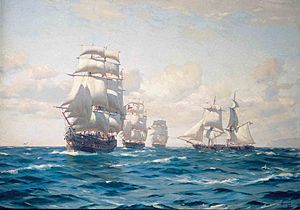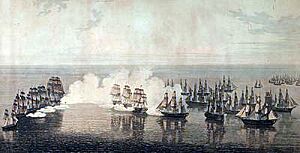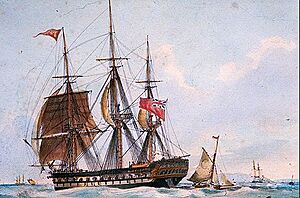Cumberland (1802 EIC ship) facts for kids

The First Chilean Navy Squadron, from left to right, San Martin (ex-Cumberland), Lautaro, Chacabuco, and Araucano in a painting by Thomas Somerscales
|
|
Quick facts for kids History |
|
|---|---|
| Name | Cumberland |
| Owner |
|
| Operator | Honourable East India Company |
| Route | England–India & China |
| Builder | Dudman's Dock, Deptford |
| Launched | 11 November 1802 |
| Honours and awards |
Battle of Pulo Aura |
| Fate | Sold to Chile 1818 |
| Name | San Martín |
| Namesake | José de San Martín |
| Cost | $140,000 ($200,000?) |
| Acquired | 20 August 1818 |
| Out of service | 27 September 1828 |
| Honours and awards |
Capture of Reina María Isabel, Perla, and San Miguel |
| Fate | Beached off Chorrilos, Peru in 1821 |
| General characteristics | |
| Class and type | East Indiaman |
| Tons burthen | 1260, 126062⁄94, or 1355 (bm) |
| Length |
|
| Beam | 42 ft 1 in (12.8 m) |
| Depth of hold | 17 ft 2 in (5.2 m) |
| Propulsion | Sail |
| Crew |
|
| Armament |
|
The ship Cumberland was a large sailing ship launched in 1802. It was a "3-decker" East Indiaman, which means it was built to carry goods for the British East India Company. This company traded between India, China, and England. The Cumberland made seven long trips for them between 1802 and 1815.
One of its most famous moments was during its second voyage. It took part in a sea battle called the Battle of Pulo Aura against a French fleet. Later, in 1818, the government of Chile bought the ship. They renamed it San Martín and made it part of their navy. As San Martín, it helped defeat a Spanish force. Sadly, the ship was wrecked off the coast of Peru in 1821.
Contents
Life as an East Indiaman
The Cumberland was a strong and important ship for the East India Company. It carried valuable goods like tea, spices, and silks across the world's oceans. These voyages were long and sometimes dangerous, facing storms and even enemy ships.
First Voyage and a Clever Battle (1803-1804)
Captain William Ward Farrer commanded the Cumberland on its first journey. He left England in January 1803, heading to places like South Africa, Bengal (India), and China. Soon after they left, the Napoleonic Wars began. This meant British ships could attack French ships.

On February 14, 1804, something amazing happened. A group of East Indiamen, including the Cumberland, were sailing home. They were led by Commodore Nathaniel Dance. They suddenly came across a much stronger French navy squadron. Even though the French had powerful warships, Commodore Dance used a clever trick. He made his merchant ships look like warships. He ordered them to sail in a line, ready for battle.
This brave and aggressive move tricked the French Admiral Linois. He thought he was facing a strong British war fleet. After a short exchange of cannon fire, the French admiral decided to retreat. Dance then chased the French ships until his convoy was safe. This battle showed how courage and smart tactics could win against a stronger enemy.
The East India Company was very proud. They gave £50,000 to be shared among the captains and crews. Captain Farrer received 500 guineas and a special plate. Other groups also gave awards to the officers. Commodore Dance was even knighted for his bravery.
Second Voyage and Another Encounter (1805-1806)
The Cumberland's second voyage also involved some action. Captain Farrer left England in April 1805, heading for India and China again.
On August 7, 1805, the Cumberland was part of a group of East Indiamen being escorted by a British warship, HMS Blenheim. They met a French warship, the Marengo, and a French frigate, the Belle Poule. There was a brief exchange of cannon fire between the ships. Both sides then continued on their way. The captains of Cumberland and another ship were told off for being too bold in fighting the French.
The Cumberland continued its journey, stopping in places like Madras, Penang, and Malacca. It reached Whampoa in China in December. After loading goods, it sailed back to England, arriving in September 1806.
Later Voyages (1807-1817)
The Cumberland made five more voyages for the East India Company. These trips followed similar routes to India and China. Captains Peter Wedderburn and Thomas Hutton Wilkinson commanded the ship during these years. Each voyage was a long journey, taking over a year to complete. The ship carried goods and faced the challenges of sea travel during wartime. Its last voyage for the company ended in May 1817.
After its long career with the East India Company, the Cumberland was sold. Bernardo O'Higgins, the leader of the Chilean government, wanted to buy strong ships for Chile's new navy. He arranged for the Cumberland to be purchased.
The ship sailed to Valparaíso, Chile, arriving on May 22, 1818. The Chileans bought it for 210,000 pesos. They renamed the ship San Martín, in honor of José de San Martín, a hero of South American independence. They also armed it with 64 guns, making it a powerful warship. William Wilkinson, who had been its captain, stayed on as its commander.
Fighting for Chile
On October 25, 1818, the San Martín became part of the First Chilean Navy Squadron. This squadron was led by Manuel Blanco Encalada. The squadron, which included San Martín, Lautaro, and Chacabuco, fought against a Spanish force. They successfully defeated the Spanish expedition, capturing several Spanish transport ships. This was a big victory for Chile.
The San Martín also took part in the Freedom Expedition of Perú. This important mission aimed to free Peru from Spanish rule. The expedition was led by Captain Lord Thomas Cochrane, a famous British naval officer. San Martín was still under Captain Wilkinson's command during this time.
The Ship's Final Journey
In July 1821, the San Martín's long career came to an end. It was wrecked in the bay of Chorrillos, Peru. A report from Chile on August 13 confirmed that the ship, which was Lord Cochrane's main ship at the time, had been lost. Luckily, the crew was saved. The ship was carrying some valuable silver, but only a small amount could be rescued. After this, Lord Cochrane moved his flag to another ship, the O'Higgins.
|


